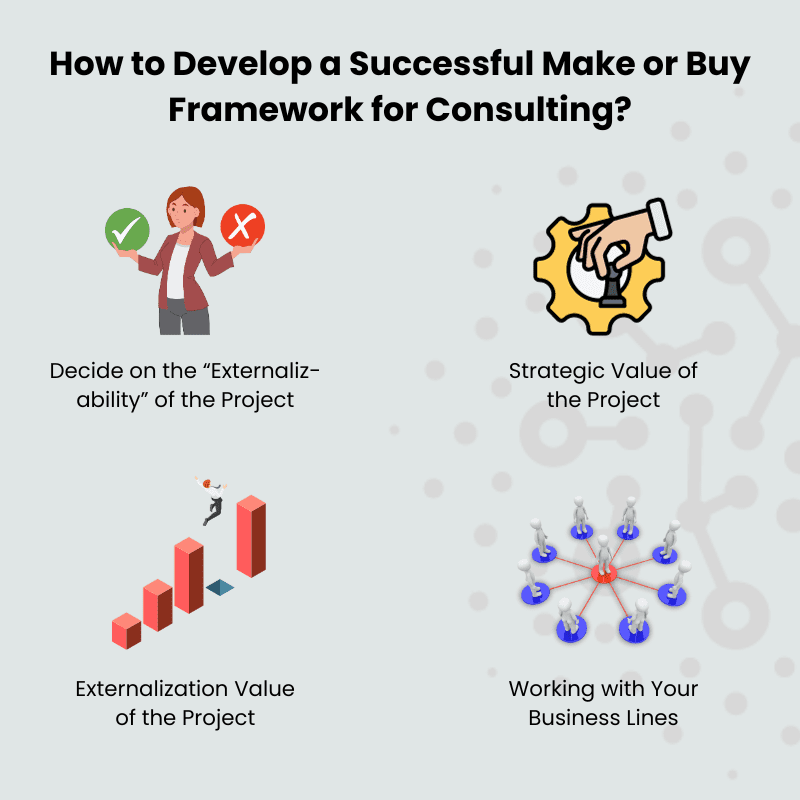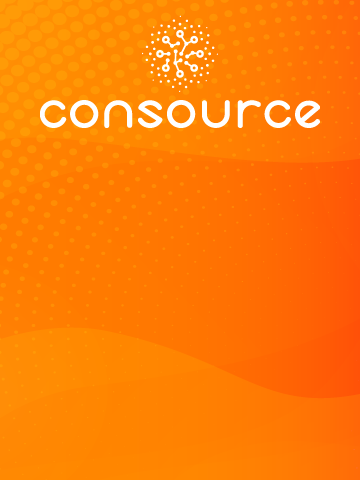Successful companies apply a sound financial management principle: Employing a make or buy framework for consulting services has to bring more value than leading the project internally.
One way to build these new practices and get the buy-in of the users is to assemble a cross-functional team including, Strategy, Finance, Procurement, and a few business lines, so all the benefits can be obtained and evaluated.
A solid and clear make or buy framework for consulting can ensure objective and efficient decisions. The framework has to be in line with your Strategy and Culture. Depending on how procurement-savvy are your executives, you might want to describe in more or fewer details about what each item means.
Here is how to successfully develop your own make or buy framework for consulting.
1. Decide on the “Externaliz-ability” of the Project
Before analyzing if a project should be externalized or not, you need to assess if the issue you want to solve and if your project is suitable for externalization. Best practices in procurement recommend having a well-defined project that can be handled independently (as much as possible) for the rest of the organization.
Few points to consider:
Can You Define Clear Deliverables for Your Project?
When embarking on a project, it’s imperative to articulate clear and measurable deliverables. These are the concrete results or outcomes you expect to achieve throughout the project’s lifecycle, considering whether to develop these in-house or utilize external consulting services within a make or buy framework for consulting.
Instead of vague aspirations like “we should do this,” well-defined deliverables establish a roadmap for success. They provide a tangible framework that ensures everyone involved understands what needs to be accomplished and how progress will be assessed.
These deliverables can take various forms, such as documents (reports, presentations), tangible assets (prototypes, software, products), or even milestones achieved in meetings or workshops (workflows, seminars).
The key is to transform abstract project goals into practical, quantifiable targets. This not only enhances project clarity but also serves as a foundation for effective monitoring, measurement, and evaluation.
Can You Define a Clear and Reasonable Deadline for the Project?
Setting a firm project deadline is not only about defining a timeframe but also ensuring it’s both realistic and aligned with your project’s priority. While high-priority projects often demand strict timelines, it’s equally essential to gauge the reasonableness of the deadline from a consultant’s perspective, especially when considering the make or buy framework for consulting.
Consider that consultants may have commitments to other projects. Expecting a project to span an excessively long time can limit their availability and focus, potentially affecting the project’s success. Striking a balance between urgency and feasibility is crucial when defining project deadlines.
What is the Level of Uncertainty Surrounding Your Project?
Uncertainty can be a project’s silent adversary, particularly when it stems from interdependencies with other internal activities. The more reliant your project is on external factors or other departments’ cooperation, the greater the risk of delays and complications.
Ideally, aim for projects that can operate as independently as possible from other parts of the organization. Minimizing dependencies reduces the chances of bottlenecks and ensures smoother project execution. Remember, consultants can’t remain on standby indefinitely, as their time is a valuable resource.
Do You Have Access to the Necessary Resources?
Assessing resource availability is perhaps one of the most critical questions in project planning. It’s essentially about determining if the skills and expertise required to fulfill your project’s objectives exist either within your organization or externally.
The key challenge here is twofold: identifying individuals or consulting firms with the capabilities to solve your specific problem and ensuring you have access to them. This question delves into the project’s feasibility. Even if the expertise exists, you must evaluate if it’s accessible and within reach to make your project a reality.
2. Strategic Value of the Project
The cornerstone of the “make or buy” decision lies in the project’s alignment with the company’s overall strategy. Assessing a project’s strategic value entails measuring how it contributes to the overarching strategic goals and objectives. This is where the intersection of “make or buy” and demand management becomes critical.
Is the Project Strategic for the Company?
While it may seem straightforward that certain projects possess high strategic value, the complexity arises when we consider projects that, on the surface, may not appear directly strategic. However, these projects can still bring substantial value when they act as enablers for other strategic initiatives.
The true essence of a strategic project lies not solely in its label but in its ability to advance the company’s overarching strategy. Does it propel the organization higher, faster, or more effectively? Does it generate tangible, hard-dollar value that can be channeled into other strategic initiatives?
What is the Expected Impact of the Project?
Projects can have a multifaceted impact, affecting various aspects of the organization, from revenue and costs to culture and leadership. Typically, projects that directly influence the top line, bottom line, and cost efficiencies take precedence due to their immediate and measurable impact.
However, it’s equally vital to recognize projects that bring long-term value, shaping the organization’s culture, leadership capabilities, and market positioning.
How Much Are You Willing to Invest in the Project?
This question delves into the financial aspect of the project. It’s not just about the cost but also about the expected return on investment (ROI). What is the worth of this project to the company, and is it financially justifiable? Understanding the financial implications is crucial to determine if the project aligns with budget constraints and offers a compelling ROI.
Is Now the Best Timing for the Project?
Timing plays a pivotal role in project execution. Even if a project holds strategic significance, it may not be the right moment to initiate it. Considerations may range from the necessity of prerequisite enabler projects to regulatory compliance deadlines. Carefully managing project timing ensures resources are allocated wisely and budgets are optimally utilized.
Incorporating these strategic considerations into the “make or buy” decision framework enhances the ability to discern which projects align best with the company’s overarching strategy and deliver the greatest value.

3. Externalization Value of the Project
After establishing the strategic value of your project, the next step is to evaluate the externalization value – essentially, the benefits derived from outsourcing the project as opposed to keeping it in-house.
Are the Skills Involved Core for Your Company?
One pivotal consideration is whether the skills required for the project align with your company’s core competencies. If your organization possesses the necessary skills and resources internally, it may make sense to execute the project in-house.
However, if these critical skills are absent or not readily available, it may be prudent to consider augmenting your existing teams and launching the project internally, all while strategically planning to acquire or develop the required skills for future projects.
This question underscores the importance of anticipation and long-term workforce planning. Building internal capabilities and transferring knowledge can reduce reliance on external consultants in the long run.
Is There a Specific Reason to Go External?
There are compelling reasons to leverage external consultants, including independent expertise, third-party validation for management decisions, or the strategic use of a consultant’s established brand to justify a potentially challenging course of action. In such cases, the involvement of external consultants becomes a pivotal success factor for the project.
Do We Improve the Business Case by Accelerating the Project?
Outsourcing a project should not merely replicate internal timelines but should deliver added value through acceleration. If expediting the project leads to increased value compared to an internal timeline, partnering with consultants becomes a strategic choice. This criterion significantly influences the decision, as it directly correlates with achieving faster results and benefits.
Do We Have the Necessary Skills and Resources to Supervise the Project?
Supervision is often an overlooked aspect of project outsourcing. To ensure successful project management, it’s essential to have a dedicated project manager who comprehends the project’s scope and the Consulting Firm’s role.
Adequate resources should also be allocated to oversee the project thoroughly. This critical supervision element underscores the importance of understanding the work being outsourced, akin to inspecting and validating goods in manufacturing processes.
Are There Companies That Can Provide That Service?
While it may seem like an obvious question, particularly for common consulting services, it’s imperative to perform due diligence, especially when the project necessitates a highly specialized or hybrid skill set. In such cases, conducting comprehensive research to identify companies with the requisite expertise is vital.
Is There Sensitive Intellectual Property (IP) or Information Involved?
The protection of intellectual property and strategic information is paramount. Assess whether the project involves sensitive IP or proprietary data. If confidentiality and security are critical, additional safeguards may be necessary when partnering with external consultants to safeguard your IP and corporate strategy.
4. Working with Your Business Lines
With your make or buy framework for consulting in place, the final step is to engage with your business lines and secure their commitment to this systematic approach.
Explain the Case for Change – Communicating the Benefits
The first crucial task is to effectively communicate the case for change to your employees, especially those in the business lines. The emphasis here should be on outlining the tangible benefits they stand to gain from implementing a systematic make or buy assessment.
Explain how this framework will help your company maintain a laser focus on its strategy while efficiently managing consulting costs. Make it clear that this approach is not just a top-down initiative but a strategic tool that can empower them to make more informed decisions about project resourcing.
Inventory the Projects – Identifying the Pool
Once your teams are onboard with the concept, it’s time to roll up your sleeves and identify the pool of projects that need to undergo the Make or buy assessment. By this stage, you may have already implemented demand management, which streamlines the selection process.
Focus on projects that align with the company’s high strategic priorities or those that exceed defined thresholds. It’s essential to have this project inventory in place, which serves as the starting point for your Make or buy journey.
Map the Benefits vs. Efforts – Prioritization
An essential filtering step involves mapping the expected benefits against the associated efforts for each project identified. This exercise provides an initial prioritization of projects, separating those with high-value creation potential from those with lower prospects. By identifying high-value, low-effort projects, you can efficiently allocate your resources and maximize the impact of your decisions.
Select Candidates for Externalization – Efficiency First
Within the prioritized list, the next step is to select projects that are easily externalizable. Prioritizing these projects initially can save time and resources, as they typically require less internal effort and adjustment.
However, this doesn’t mean that highly beneficial but complex projects should be entirely excluded. You can consider revisiting them later with a more robust framework or retainer structure once the low-hanging fruit has been addressed.
Apply a Make or buy Framework for Consulting Matrix – Decision Visualization
To refine your project selection, create a Make or buy matrix based on your specific criteria. This matrix serves as a decision-making tool that allows you to visualize the results, making the selection process more transparent and data-driven. It provides a structured approach to assess each project against predefined criteria, helping you make informed choices.
Implement Governance – Supervising the Strategy Matters
Establishing governance is the final piece of the puzzle. Define how the Make or buy strategy will be managed and monitored within your organization. The governance structure should align with your company’s overall structure and culture.
For highly centralized companies, consider a central Consulting Committee responsible for examining different projects and overseeing results company-wide. In decentralized organizations, contemplate multiple committees aligned with business units or functions.
Supervise and Refine – A Continuous Cycle
The journey doesn’t end with implementation; it’s a continuous cycle. Regularly supervise the application of the make or buy framework for consulting. Don’t just check if assessments are completed but also evaluate how they are done.
Collect feedback, adapt your tools and processes, and iterate. This dynamic approach ensures that your Make or buy strategy remains relevant, responsive, and aligned with your organization’s evolving needs.
Conclusion: Make or buy Framework for Consulting
In the world of consulting, where decisions often shape the future of businesses, the make or buy framework for consulting, when coupled with effective demand management, becomes an invaluable tool. However, as organizations embark on this journey, certain fundamental principles must remain at the forefront of their decision-making process.
Every project is unique, and recognizing the ones that are best suited for externalization is key. Striking a balance between internal and external resources can significantly impact project outcomes and cost efficiency. Internal talent should never be underestimated; it’s a valuable asset that, when nurtured, can yield long-term benefits.
Value should be the North Star guiding every decision. Projects, whether handled internally or externally, must align with the company’s overarching strategy. The focus should not only be on short-term gains but also on long-term value creation.
The make or buy framework for consulting should remain flexible, capable of adjusting to evolving circumstances. A pragmatic approach, rooted in real-world needs and conditions, should drive decision-making.
As organizations grapple with the complexities of make or buy decisions, these principles serve as guiding lights. By choosing wisely, leveraging internal resources, prioritizing value, and maintaining agility, companies can navigate the intricate terrain of project resourcing with confidence and precision.
make or buy framework for consulting make or buy framework for consulting make or buy framework for consulting make or buy framework for consulting
make or buy framework for consulting make or buy framework for consulting make or buy framework for consulting make or buy framework for consulting
make or buy framework for consulting make or buy framework for consulting make or buy framework for consulting make or buy framework for consulting
make or buy framework for consulting make or buy framework for consulting make or buy framework for consulting make or buy framework for consulting
make or buy framework for consulting make or buy framework for consulting make or buy framework for consulting make or buy framework for consulting

How Consource Can Help?
Consource functions as a decision-making tool, facilitating the implementation of demand management, evaluating a project’s strategic worth, achieving a harmonious blend of internal and external resources, and ensuring data-driven accuracy in your selections.








0 Comments